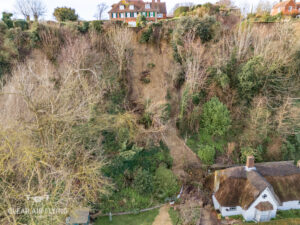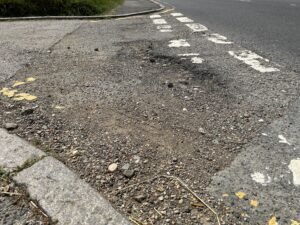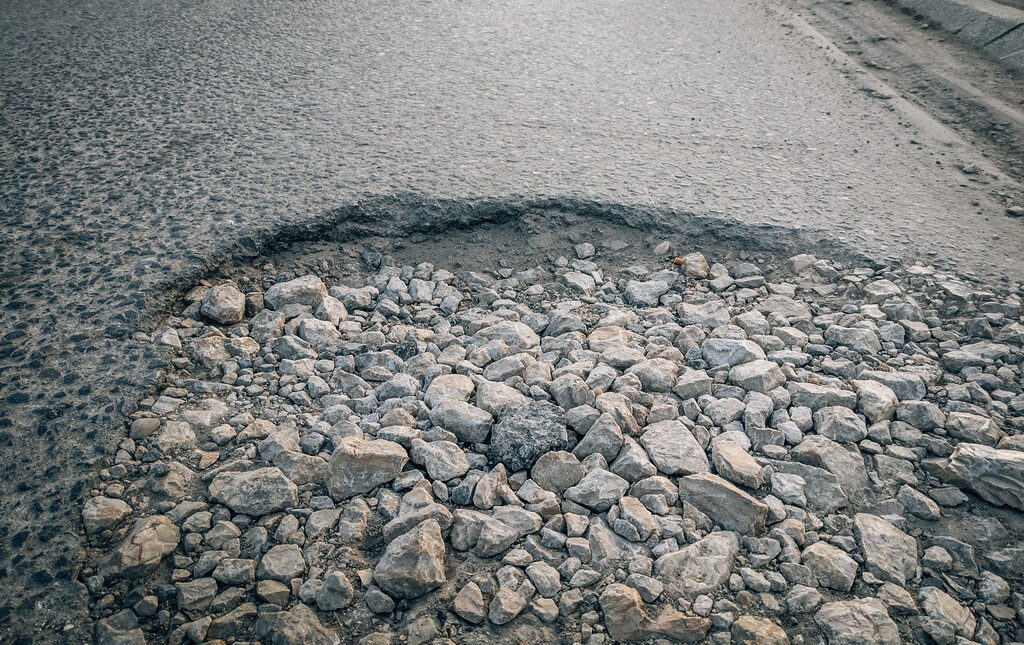Guy Harris’ article on potholes in Rye News last month fails to mention the elephant in the room, which is climate change – merely ascribing blame for potholes to ‘the weather’.
Landslides and potholes are the direct result of climate change. Last month was the world’s warmest February ever, extending the run of monthly records to nine in a row – each month since June 2023 has seen new temperature highs. Carbon dioxide concentrations are at their highest level for two million years.
Increased CO2 emissions generate more moisture in the atmosphere, which leads to more rainfall. The south of England had its wettest February since 1836. After periods of intense rainfall the ground is saturated, and as rain continues the pressure increases until it leads to the structural failures (landslips) which we have seen in Military Road, Dumb Woman’s Lane and locations in Hastings. Increased rainfall (plus more and heavier traffic) also cause potholes.

Cars are the primary source of transport CO2 emissions in the UK, accounting for 52% of all vehicle emissions in 2023. Clearly, we need a ‘modal shift’ to more sustainable, less polluting ways of getting around. An added bonus is that the health and social benefits of walking and cycling routes demonstrate returns of £5 for every £1 spent, not including the savings to the NHS of a healthier population (especially urgent given that 64% of all adults in the UK are overweight).
This is not a message which our transport authority, East Sussex County Council appears to grasp, following a decade of under-investment where they have achieved virtually nothing. The schemes they have promoted are poor quality, or not connected to each other. You can’t expect parents to allow their children to cycle on a route which ends in a dangerous roundabout, for instance. The number of
people cycling in East Sussex has declined, which is hardly surprising when you consider somewhere like Eastbourne where buses, taxis and delivery vans are allowed in the town centre but cyclists are banned, forcing them onto busier roads.
And this was meant to be ESCC’s flagship town for active travel!

At the Rye annual town meeting Councillor Keith Glazier trumpeted the £1.22m ESCC received in 2023 from Active Travel England but unfortunately their track record shows that ESCC has neither the ambition nor the skills to deliver, with almost the entirety of their meagre active travel budget previously having been spent on design, assessments, reviews, process, salaries and consultations. They haven’t built a single cycle route in the last six years.
We need to start having difficult conversations about how we re-allocate road space to allow people the option of healthier, more sustainable transport. Of course plenty of us rely on cars, especially in rural areas (myself included). But we also need to make safer routes for walking, wheeling and cycling if we’re to tackle the causes of climate change – and those pesky potholes.
How can we create better and safer active travel routes through Rye? Please come
to an open meeting of the Rye Bay Cycle Forum at the Queens Head (19 Landgate) at 7pm on Wednesday, March 27. For more information email info@sussexgreenways.org.
Image Credits: Ivan Radic https://www.flickr.com/photos/26344495@N05/51108423069 CC https://creativecommons.org/licenses/by/2.0/, Clear Air Flying , James Stewart .




Just returned from a holiday in Cornwall and I’m pleased to announce that compared to this area, their roads are decidedly in much better shape, far superior and I believe they have a similar climate down there.
So who actually measured the Co2 levels 2 million years ago ?
Asking for a friend !!!!
C02 levels millions of years ago are determined by what is called proxy data, usually ice cores or tree rings. Completely accurate measurements of temperature of the earth and other important data has been a relatively recent development using satellites. There is also other data around including well known paintings of for instance, the Thames frozen over with people skating and market stalls, supporting evidence of the ‘little ice age’ period.
Empirical evidence from scientific analysis of polar ice core and geological sediment samples.
Pothole situation aggravated by increasing numbers of larger, heavier cars driven too fast for road conditions.
I agree with most of your comments, Nick. Global heating is causing a lot of the pothole issues, and landslips, with more rain. Electric cars are of course becoming more common, as are electric bicycles. The primary problem for ordinary bicycle use is that of hills. The hills in Rye make cycling difficult for all but the very fit. I’d ask that people support the current push to allow a doubling of electric bicycle power to 500W, because the current legal limit of 250W is insufficient to cope with many hills. Cycling helmets on these bikes should probably be mandatory and perhaps some thought given to speed limiters if speeding causes a problem in future.
On a happy note, I can confirm that the infamous pothole hotspot Deadmans Lane is currently being resurfaced with tarmac and is close to completion, while I hear that Rye Harbour Road’s potholes are also due to be filled some time this month.
Sorry to “jump in” on this… Does anyone know who is responsible for the road at the top of Rye Harbour,from the bus turnaround point to the holiday park? I have tried reporting the large potholes nr the car park,to be told that it doesn’t belong to either the highways or ESCC ?
Oh and East Sussex highways have informed me that from the Jehovahs Witness Church to Atlas Buisness Park DOES NOT need repairing ,how they have worked that one out I have no idea ♀️I have reported umpteen times and get the same answer